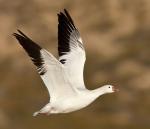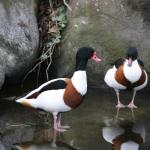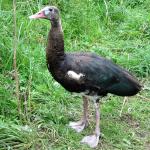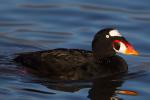|
|

|
Red-breasted Merganser
|
Overview
Red-breasted Merganser: Medium-sized diving duck with black upperparts, gray sides, rust-brown breast, and white belly. Head, double crests, and neck are green and the neck ring is white. Bill is long, thin, and bright orange. Feet and legs are orange. Feeds mostly on fish, which it finds by diving. |

|
Red-necked Grebe
|
Overview
Red-necked Grebe: Large grebe with dark gray upperparts and cap, white underparts with gray flanks. Lower face and nape are white; neck is red-brown. Eyes are dark brown. Long thick yellow bill with dark tip. Black legs, feet. Dives for small fish and crustaceans. Direct flight on rapid wing beats. |

|
Red-throated Loon
|
Overview
Red-throated Loon: Small loon with scaled gray back and white underparts. Head and sides of neck are gray, throat is dark red, nape is black-and-white striped. Eyes are red. Feeds on fish, dives to 90 feet for them. Direct flight, rapid wing beats. Only loon to leap into flight from water or land. |

|
Redhead
|
Overview
Redhead: Medium diving duck, gray back and sides, black upper back, breast, rump, and tail, and white belly. Head and neck are rufous-brown, and blue-gray bill is black-tipped; eyes are yellow. Feeds mostly on aquatic vegetation. Rapid direct flight with strong wing beats, flies in V formation. |

|
Ring-necked Duck
|
Overview
Ring-necked Duck: Medium-sized diving duck. Black upperparts, weakly tufted, purple-black head. Neck, upper breast, tail are black, lower breast and belly are white, sides are pale gray. Cinnamon collar is hard to see in the field. Dark wings have black-tipped gray flight feathers visible in flight. Blue-gray bill, white ring, black tip. |

|
Ross's Goose
|
Overview
Ross's Goose: Small, white goose with black primary feathers and stubby gray-based red-orange bill. Red-orange legs and feet. Eats mostly fresh grasses and grains, often in the company of Snow Geese. Rapid direct flight with strong wing beats. Flies in a V formation. North America's smallest goose. |

|
Ruddy Duck
|
Overview
Ruddy Duck: Small duck, bright red-brown body; black cap extends below the eyes and onto the nape, contrasting sharply with white face; heavy bill is blue. Tail is black, often held erect when swimming. Some males show all black head, lacking white cheek patches. Direct flight on rapid wing beats. |

|
Shelduck
|
|
The shelducks, genus Tadorna, are a group of large birds in the Tadorninae subfamily of the Anatidae, the biological family that includes the ducks and most duck-like waterfowl such as the geese and swans. |

|
Smew
|
Overview
Smew: Small merganser, mostly white body except for black back, mask, breast bar, and V-shaped nape patch. Wings are dark with large white patches. Gray legs, feet. Feeds on fish, aquatic insects, and their larvae. Swift direct flight with rapid wing beats. Flies in straight line or V formation. |

|
Snow Goose
|
Overview
Snow Goose: Large goose with two color phases. White phase is all white with black wing tips. Blue phase has white head and neck, blue-gray upperparts, gray-brown breast and sides, white belly. Pink bill, black lower mandible. Pink legs, feet. Strong direct flight in bunched flocks or U formations. |

|
Spectacled Eider
|
Overview
Spectacled Eider: Smallest of the Eiders, has orange bill, white upperparts, black underparts, breast, sides, black pointed tail, yellow-green head and large white "goggles" bordered with black. White feathers on the upper mandible extend past nostril. Rapid direct flight in straight line formation. |

|
Spot-billed Duck
|
Overview
Spot-billed Duck: Native of Asia, named for red spots at base of yellow-tipped black bill; subspecies occurring in North America generally lacks these spots. Scaled brown overall with buff face, neck, upper breast. Dark crown, nape, eyestripe. Blue speculum with white borders; orange legs and feet. |

|
Spur-winged Goose
|
|
The Spur-winged Goose is the world's largest goose and comes from sub-Saharan Africa. It has 2cm bony spurs on its wings for defending territory and fighting.
Shown here is a young male Black Spur-winged Goose, the sub-species from southern Africa with little white on its chest and side and less white on its belly. |

|
Steller's Eider
|
Overview
Steller's Eider: Small eider with black back and collar, white sides, buff-brown underparts with small but distinct black spot on side. White head has a dark tuft, black eye patch and chin. Wings are white with black primaries and a white-bordered blue speculum. Blue-gray bill, legs and feet. |

|
Surf Scoter
|
Overview
Surf Scoter: Medium diving duck, entirely black except for white patches on forehead and nape. Bill is orange, black, and white. Eyes are white. Legs and feet are orange. Dives for food, primarily mollusks and crustaceans. Rapid direct flight with strong wing beats. Flies in straight line formation. |

|
Trumpeter Swan
|
Overview
Trumpeter Swan: Largest swan in the world, completely white but with head and neck often stained rust-brown from contact with ferrous minerals in wetland soils. Bill, legs, and feet are black. Feeds on aquatic plants. Strong direct flight on steady wing beats. Flies in straight line or V formation. |

|
Tufted Duck
|
Overview
Tufted Duck: Medium-sized diving duck with long black crest and dull black back and tail. Underparts and sides are bright white. Head, neck and breast are black with a purple sheen. Wings are black with dark-edged, broad white stripes visible in flight. Eyes are yellow; legs and feet are gray. |

|
Tundra Swan
|
Overview
Tundra Swan: Small swan, completely white, head and neck often stained rust-brown from ferrous minerals in marsh soils. Black bill, usually with yellow spot at base. Black legs, feet. Strong direct flight on steady wing beats. Flies in straight line or V formation. Most common swan in North America. |

|
Western Grebe
|
Overview
Western Grebe: Large, long-necked grebe with dark gray upperparts, white underparts, gray sides and flanks. Lower face and front of neck are white; black cap extends below eye. Back of neck is black. Eyes are red. Bill is long, thin, and dull olive-yellow. Wings have white stripes visible in flight. |

|
White-cheeked Pintail
|
Overview
White-cheeked Pintail: Large, heavily spotted dark and light brown duck with striking white cheek patches, blue bill with bright red base, buff pointed tail. Legs and feet are blue-gray. Feeds on aquatic plants, small invertebrates. Swift direct flight with strong rapid wing beats. AKA Bahama Duck. |

|
White-fronted Goose
|
|
Greater White-fronted Geese are 64–81 cm (25–32 in) in length, have a 130–165 cm (51–65 in) wingspan and weigh 1.93–3.31 kg (4.3–7.3 lb). They have bright orange legs and mouse-coloured upper wing-coverts. They are smaller than Greylag Geese. As well as being larger than the Lesser White-fronted Goose, the Greater White-fronted Goose lacks the yellow eye-ring of that species, and the white facial blaze does not extend upwards so far as in Lesser. |

|
White-winged Scoter
|
Overview
White-winged Scoter: Medium sea duck, mostly black except for white eye patches, large white wing patches. Bill is orange with large black basal knob. Red-orange legs, feet. Dives to 40 feet, feeds primarily on shellfish. Direct flight with steady wing beats. Flies in straight line or V formation. |

|
Whooper Swan
|
Overview
Whooper Swan: Large, white swan with black and yellow bill; broad, yellow patch covers at least half of the upper mandible. Black legs and feet. Feeds by dipping head and neck in water. Eats invertebrates and aquatic plants. Strong direct flight with deep and steady wing beats. Flies in V formation. |

|
Wood Duck
|
Overview
Wood Duck: Small tree duck with brown back, white throat, purple-brown breast with white flecks grading to white belly; buff-yellow flanks. Crested head is green and purple with white stripes; white throat has two bars, one extends as a partial collar, the other extends behind and below eyes. |

|
Yellow-billed Loon
|
Overview
Yellow-billed Loon: Large loon, white-spotted black upperparts, white underparts, gray sides with fine white spots. Head is glossy green-black; neck has black-and-white rings. Yellow bill. Dives for small fish, crustaceans. Direct flight on deep wing beats. Solitary, or in pairs and family groups. |
|
|